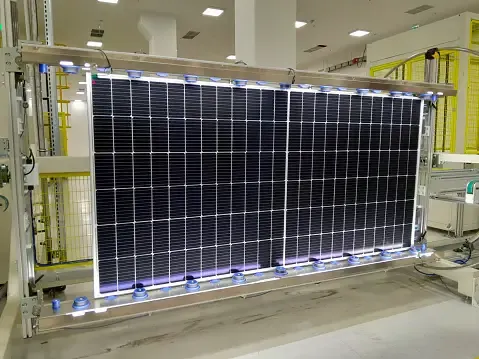
What Does a Hybrid Solar Inverter Do?
Hybrid solar inverters are becoming increasingly popular because they provide two different kinds of services under one roof, thus creating curiosity among households.
So, what are hybrid solar inverters? And what do they do? To clear all such confusion, we have developed this guide, which will help you understand the basics of hybrid inverters and shed light on their functionalities and crucial aspects.
What is a hybrid solar inverter?
A hybrid solar inverter is a device that combines the features of a traditional solar inverter and battery. Such a type of solar inverter can convert power from direct current into alternate current and safely store it for later usage.
Thus, it established itself as a one-stop destination for all the power needs in today’s modern world where everyone seeks a cost-efficient option.
How does a hybrid solar inverter work?
The working process of a hybrid solar inverter can be understood with the steps discussed below:
1.Energy collection: Solar panels generate DC by absorbing sunlight via photovoltaic cells.
2.AC to AC conversion: As everyday appliances and most machinery can not work on DC, the current produced must be converted to AC. An inverter performs this job by converting all the energy from solar panels.
3.Power supply to appliances: The inverters direct AC to multiple parts of the house so that the appliances can work. It is an immediate use of converted solar energy.
4.Battery charging: An appliance can not consume all the generated electricity. Nor does the sun stay 24/7. The same is why battery storage systems store the excess energy used when the sun is absent. In the case of a hybrid inverter, a battery bank is present within the inverter. Hence, you do not have to purchase or attach any extra components to the system.
5.Grid integration: The hybrid solar inverter supplies electricity and monitors your average energy demand. If the inverter cannot provide the needed power from solar panels, it draws additional power from the grid system.
6.Energy support: If the battery bank is fully charged and the house doesn't need it, the inverter will supply the excess energy back to the grid system through the solar panel. Selling the excess power to the government can also earn homeowner credits, compensation, and tax benefits.
Traditional inverters vs hybrid inverters
Here are some prominent differences between hybrid solar inverters and traditional inverters:
1.Functionality: Traditional inverters only convert current, whereas hybrid inverters also interact with the grid to export surplus energy.
2.Cost: Simple inverters generally cost less. Hybrid inverters, with complex integrations, have a slightly higher upfront cost, but this pays off in the long run.
3.Energy optimization: Normal inverters convert energy for immediate use. On the other hand, the hybrid inverter also stores it for later use.
System management of hybrid solar inverters
The hybrid solar inverters have inbuilt monitoring and management systems. These systems aim to provide real-time data on energy production and battery consumption to help households determine their exact need.
In addition, the system's performance can also be seen and monitored through your manufacturer's dedicated app or web portal.
Functions of a hybrid solar inverter
A hybrid solar inverter performs some of these significant functions.
1. Facilitating off-grid energy
A hybrid inverter helps you become self-sufficient regarding your daily energy needs. With the help of such an inverter attached to the solar panels, you can generate a significant amount of free energy and store it for later use.
Thus, 100% of the self-sufficiency from the traditional grid system has been achieved for a long time.
2. Cost efficiency
A battery and an inverter are two must-have options for a power-generating system. However, purchasing both separately can be very time-consuming.
Nevertheless, with a minimal increase in price compared to regular inverters, you can get a hybrid inverter.
As they have a built-in battery bank, you do not need to have another unit installed, which helps you save a lot of bucks in the long run.
3. Load management
The load can fluctuate if you are connected to the traditional grid system. In all such cases, hybrid inverters are helpful as they generate current and manage the load to ensure optimal energy use.
At the same time, they prevent overloading to mitigate the risks of short circuits and fuse-offs.
4. Monitoring and controlling
Hybrid inverters have extensively advanced monitoring features. It allows users to track energy products and consumption. At the same time, it also helps you know the information about storage levels in real time.
5. Backup power supply
During peak hours, the sun might create more energy than the actual demand for your house. In such cases, the extra power goes to waste because you do not require it.
But not anymore because the hybrid inverter helps you save this energy for later use. Or you can trade the excess current generated with the government through local governing bodies to get exemptions on tax and other benefits.
How do we optimize the benefits of hybrid inverters?
While there are multiple benefits to obtaining a hybrid inverter, only one way to avail yourself of those is by investing in a good-quality inverter.
Innotinium, with years of experience, has multiple hybrid inverters to match your tailored needs. All the hardware is designed to fit in spaces of every design and size without any problems. At the same time, each unit has undergone a specific set of tests to ensure 100% safety and security for every user.
Conclusion
In summary, hybrid inverters are a relatively new addition to the power generation system. These devices have an inbuilt battery bank, which provides service for both an inverter and a battery.
To learn more about this amazing device, including its features, functions, and how it works, read the whole content from start to finish. Nevertheless, to maximize the benefits, purchase it from a reputed source like Innotinum.

